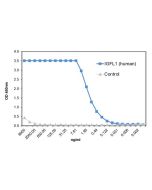Cookie Policy: This site uses cookies to improve your experience. You can find out more about our use of cookies in our Privacy Policy. By continuing to browse this site you agree to our use of cookies.
AdipoGen Life Sciences
anti-IGFLR1 (human), pAb (IN101)

| Product Details | |
|---|---|
| Synonyms | IGF-like Family Receptor 1; Transmembrane Protein 149; TMEM149; U2 Small Nuclear RNA Auxiliary Factor 1-like 4 |
| Product Type | Polyclonal Antibody |
| Properties | |
| Source/Host | Rabbit |
| Immunogen/Antigen | Recombinant human IGFLR1 (aa 23-154). |
| Application |
Flow Cytometry: (1:500) Note: Tested on recombinant proteins and/or target-protein transfected cell lines in ELISA, Western Blot and/or FACS. |
| Crossreactivity | Human |
| Specificity |
Recognizes human IGFLR1. Does not recognize mouse IGFLR1. |
| Purity Detail | Protein A-affinity purified. |
| Concentration | 1mg/ml |
| Formulation | Liquid. In PBS containing 10% glycerol and 0.02% sodium azide. |
| Isotype Negative Control | |
| Shipping and Handling | |
| Shipping | BLUE ICE |
| Short Term Storage | +4°C |
| Long Term Storage | -20°C |
| Handling Advice |
After opening, prepare aliquots and store at -20°C. Avoid freeze/thaw cycles. |
| Use/Stability | Stable for at least 1 year after receipt when stored at -20°C. |
| Documents | |
| MSDS |
 Download PDF Download PDF |
| Product Specification Sheet | |
| Datasheet |
 Download PDF Download PDF |
Insulin-growth factor-like gene family is a new family of proteins consisting of four proteins in humans (IGFL1 to 4) and one in mice (mIGFL). mIGFL is expressed in normal skin in mice and further upregulated during inflammation responses in skin or after skin wounding. In human only IGFL1 expression is increased in psoriatic skin samples. Mouse IGFL and human IGFL1 and 3 interact with specificity and high affinity to a novel receptor named IGF-like family receptor 1 (formerly TMEM-149). Analysis of the amino acid sequence of IGFLR1 indicated that this receptor is likely a novel member of the TNFR family. IGFLR1 is expressed most abundantly on mouse T cells, suggesting that mIGFL and IGFL1 produced in the skin may potentially exert regulatory functions on T cell responses.






